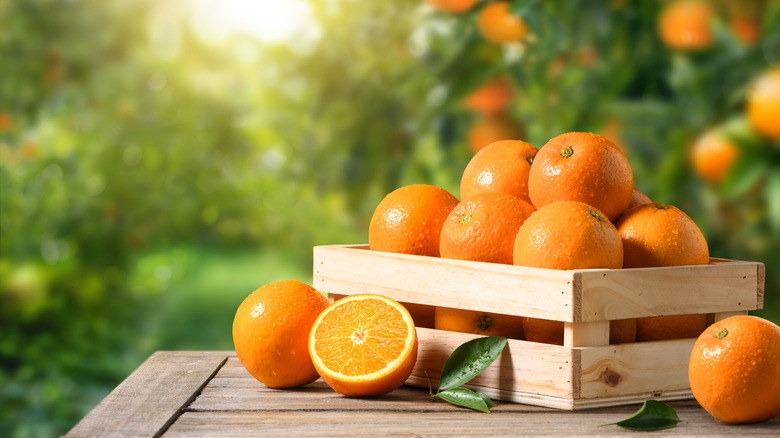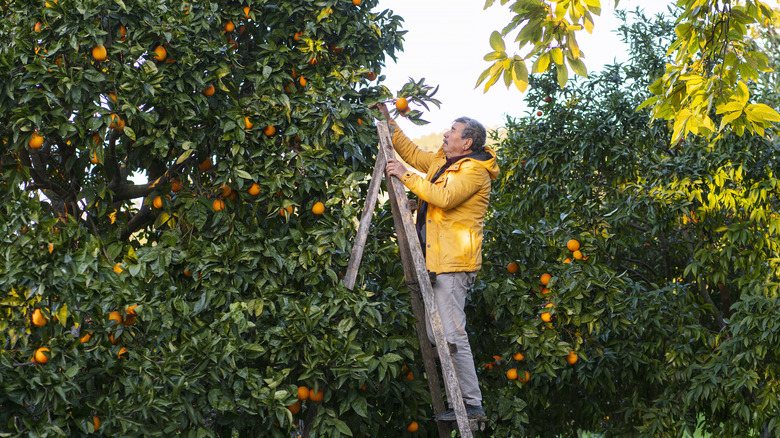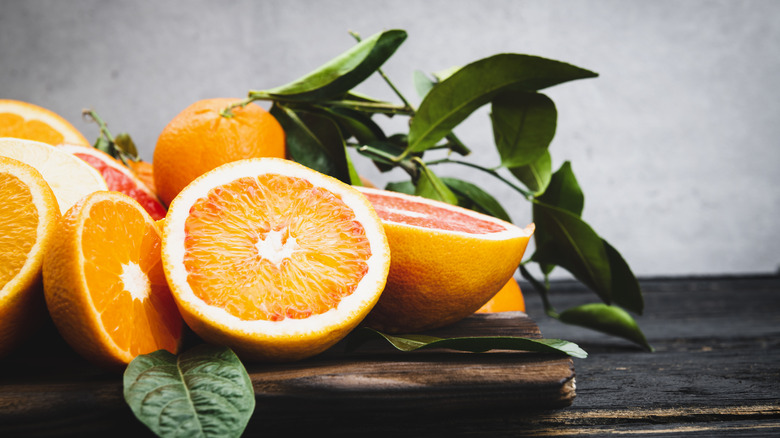Why You're More Likely To Find California Oranges In Florida Grocery Stores
Upon perusing the many citrus varieties in a Florida grocery store, you might notice that the oranges are labeled as a product of California, not of Florida. Despite the USDA forecasting a total of more than 20.5 million boxes at the end of Florida's 2023-2024 growing season, you won't be seeing these particular oranges on store shelves. As it turns out, only a little over 6% of Florida oranges are sold fresh for consumption, with the remaining 94% being processed and turned into juice. Conversely, around 80% of California oranges are sold fresh, with the remainder being processed.
For the most part, these numbers boil down to the physical attributes of the fruit. Florida's humid climate gives rise to juicier oranges, ideal for producing more orange juice with fewer and smaller fruit. These oranges aren't always the prettiest, usually possessing a greenish tinge, but they impart great flavor once processed. Meanwhile, California's drier weather results in sweeter oranges that are far easier to peel –- we like pith-free orange segments, okay? It also doesn't hurt that these oranges are usually larger and much more visually appealing than those from Florida. So, even in a Floridian grocery store, most oranges for sale will be from sunny California.
Florida orange crops struggle with each passing year
Although Florida's 20.5 million boxes of oranges are nothing to scoff at, it's worth noting that Florida produced 203.8 million boxes in the 2007-2008 growing season. That's nearly a 90% decrease in production over the course of just 16 years.
Of course, this dramatic decrease is due in large part to hurricane damage. According to the University of Florida, 2022's Hurricane Ian resulted in citrus losses worth upwards of $247 million across more than 375,000 acres. Countless fruit-bearing trees were wiped out, and even though some have since been replaced, their numbers haven't recovered. What's more, many orange trees take at least six years to reach full maturity, meaning they don't produce fruit their first few years.
Another troublesome factor is citrus greening disease, introduced by an invasive insect species in 2005. This illness leads to smaller, misshapen fruit and bitter juice, and remains incurable. In addition to trees dying off from the disease, farmers have also been forced to use more fertilizer to promote growth, which simultaneously drives up market prices.
California orange production faces its own issues
As you can imagine, California's orange crops are not subjected to the same problems as those in Florida. For one, California does not experience hurricanes, so its orange trees do not face damage from flooding or extreme winds. Rather, if anything, California oranges may struggle with the occasional drought and temperatures fluctuating too high or too low. Too hot, and the trees will drop their fruit too early, but too cold, and the trees can die of frostbite.
That being said, California's orange crops have been largely shielded from citrus greening disease. The few trees detected to carry the disease are quickly quarantined to prevent further spread, and their fruit is not sold off for consumption or processing. To be clear, citrus greening disease is not harmful to humans or animals, though it negatively affects oranges' appearance and taste. In short, you don't want to use diseased fruit to make fluffy orange juice, no matter where the oranges are from. But for these reasons, even though California oranges have taken a hit, it hasn't been to the same extent as those in Florida, which partially accounts for California oranges being sold in Florida.



